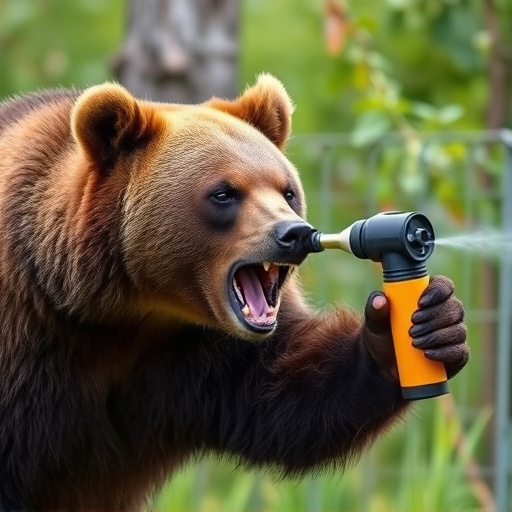Bear spray is a crucial safety tool for navigating bear country, creating an irritant barrier against charging bears within a 30-foot range. Effective deployment requires understanding its composition and technique, aiming for the bear's face and eyes. Choosing the right holster – standard belt or backpack attachments, discreet pocket holsters, or specialized vests – ensures quick accessibility during encounters. Proper training through regular practice sessions with secure holstering enhances preparedness, fostering swift and effective action in life-threatening situations.
In bear country, knowing how to respond to an encounter is crucial for safety. One effective tool many hikers and outdoor enthusiasts carry is bear spray—a powerful deterrent that can stop a charging bear in its tracks. This guide delves into the effectiveness of bear spray, covering composition, application techniques, holster options, and essential training practices. Learn the ins and outs of carrying bear spray safely and be prepared for any unexpected encounters with these majestic yet potentially dangerous animals.
- Understanding Bear Spray: Composition and Functionality
- Effective Range and Application Techniques
- Holster Options: Carrying Bear Spray Safely
- Training and Practice: Ensuring Preparedness in Bear Country
Understanding Bear Spray: Composition and Functionality
Bear spray, also known as bear repellent, is a crucial tool for anyone venturing into bear country. Comprehending its composition and functionality is key to knowing how effective it can be against charging bears. This powerful aerosol is designed to create a barrier between you and the bear by releasing a high-pressure stream of capsicum (a type of chili pepper) and other ingredients.
When deployed properly, bear spray creates an irritant that temporarily blinds and disorients the bear, giving you valuable time to retreat or defend yourself. To ensure safety, it’s essential to learn how to securely holster and carry bear spray. This includes understanding the recommended distance for spraying (around 20-30 feet) and practicing proper technique. Always keep it within easy reach, preferably in a holster designed for quick deployment, allowing you to respond swiftly if encountered by a bear.
Effective Range and Application Techniques
Bear spray, when used correctly, can be an effective deterrent against charging bears. The key to its success lies in understanding the effective range and application techniques. Typically, bear spray has a reach of about 30 feet (9 meters), allowing users to deploy it from a safe distance. However, it’s crucial to remember that this range can vary based on factors like wind, terrain, and the specific product’s nozzle design.
To ensure effectiveness, learn proper application techniques. Aim for the bear’s face and eyes, as these are sensitive areas. Hold the canister upright while squeezing the trigger in a smooth, continuous motion. Practice with a mock spray or target range to get comfortable with deployment speed and accuracy. How to safely holster the bear spray after use is also vital; store it out of reach and ensure it’s secure to avoid accidental discharges.
Holster Options: Carrying Bear Spray Safely
When it comes to carrying bear spray, choosing the right holster is essential for safety and accessibility. There are various options available, each designed to suit different preferences and activities. Some opt for standard holsters that attach to belts or backpacks, providing easy access during outdoor adventures. These holsters often feature a simple design with a secure latch mechanism, ensuring the spray remains in place even when moving through dense forests or rugged terrain.
For those seeking a more discreet approach, pocket holsters offer a compact solution. These are designed to fit comfortably in a jacket or pants pocket, keeping the spray readily available without drawing unnecessary attention. Additionally, specialized vests with built-in compartments provide easy access and distribute weight evenly, making it ideal for extended outdoor activities like hiking or camping. The key is to select a holster that fits well, allows quick deployment, and aligns with your specific needs when facing potential bear encounters.
Training and Practice: Ensuring Preparedness in Bear Country
In bear country, proper training and practice are essential for ensuring preparedness. Learning how to safely holster and deploy bear spray is a crucial skill that can make a significant difference in potentially life-threatening situations. Start by familiarizing yourself with the type of bear spray you have, understanding its range and effectiveness against charging bears. Practice making quick, controlled movements to draw and activate the spray, ensuring you follow safety guidelines for both yourself and nearby individuals. Regular training sessions will help you develop muscle memory, enabling swift reaction times when facing an actual bear encounter.
To safely holster bear spray, it’s important to keep it within easy reach while allowing for a firm grip. Many bear spray holsters are designed for attachment to your belt or backpack straps, making them easily accessible. Ensure the holster is secure to prevent accidental deployment during movement. Regularly check and test your holster to ensure it remains functional and in good condition. Additionally, practice deploying the spray from various angles and distances to simulate real-world scenarios, further enhancing your ability to respond effectively when confronted by a charging bear.
Bear spray is a valuable tool for safety in bear country, proving effective against charging bears when used correctly. Understanding its composition, range, and application techniques is key. Additionally, learning how to safely holster your bear spray and training with it can make all the difference in real-world scenarios. By mastering these skills, folks venturing into bear habitats can navigate these encounters with increased confidence and preparedness. Remember, knowledge and proper use are paramount when it comes to defending against a potential bear attack.
